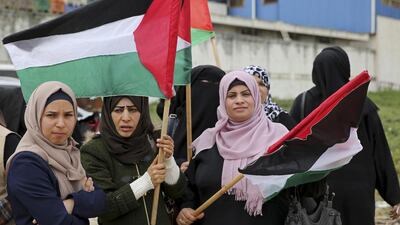March 30, 1976 was a transformative moment in Palestinian history. On that day, Palestinian citizens of Israel organised and implemented a nationwide strike to protest against the Israeli government’s plans to confiscate thousands of hectares of Palestinian-owned land in the Galilee region. The confiscations were designed to provide for the expansion of the Jewish population in the Galilee – since Israeli leaders were concerned that the composition of the region had remained overwhelmingly Arab.
Confiscations were nothing new. Between 1948 and 1976, Israel had seized 600,000 hectares of Palestinian-owned land – about one-third of the land mass of the state of Israel – much of it from Palestinians who had been expelled in 1948. But it was this effort to Judaise the Galilee that proved to be “the straw that broke the camel’s back”. The Arabs said “enough” and had the organisational wherewithal to act.
The strike, which was called the “day in defence of the land”, was planned as a peaceful demonstration of Palestinian resolve and was restricted to all-Arab villages and towns. It involved tens of thousands of people.
The success was muted however by the violence used by the Israeli police against the demonstrators. Israeli forces killed six and injured over 100 Arab citizens. Since that day, on March 30 each year, Palestinians worldwide have held Land Day events.
Arabs and Palestinians in the diaspora became aware of and inspired by their brethren in Israel. Witnessing their steadfastness, the level of organisation they demonstrated and the genius of their tactics was inspirational. In one fell swoop, the Palestinians in Israel went from being unknown to being respected as an integral part of the Palestinian community. In succeeding years, Land Day events spread from Israel to the territories occupied in 1967, the refugee camps in Lebanon and Jordan, and Palestinian communities across the globe.
Not only had the rest of the Arab world been cut off from the community inside Israel, the Palestinian Arabs of Israel had also been cut off from their compatriots. Israel had made a determined effort to erase their culture and attachment to their Arab heritage. They were forced to study Hebrew and learn an Israeli version of their history. Land Day, and the region’s reaction to it, strengthened their Palestinian identity and their feeling of connection to their broader nation.
They were the indigenous inhabitants of that land and the remnant of the Palestinian nation that had been dispossessed and dispersed among the nations. And so they saw their defence of the land as an action on behalf of their entire people.
This had long been a theme of the Palestinian poets in Israel. They wrote of their deep roots and love of the land. They lamented the hundreds of Palestinian villages that had been destroyed by Israel and spoke longingly of their refugee compatriots who sought to return. While their poetry was known throughout the community in Israel and had helped to shape the consciousness of a generation, the political empowerment of the Palestinians in Israel had been inhibited by a combination of state repression and the difficulties they experienced as a traditional and oppressed people who had been forced to adapt to the Israeli system and transform themselves into a modern political force. Land Day changed that.
Israel had banned the creation of Arab political parties and for two decades applied a notorious system of repressive laws to regulate Arab political activity. It was significant that the first effort at creating a political party was called Al Ard (The Land). In short order, Israel banned the party and expelled its founders. During this period the only political vehicle available to the Palestinian citizens of Israel was Rakah. Though officially communist, Rakah had become the substitute nationalist party for the Arab population. It was through Rakah that Tawfiq Zayyad had been elected to the Knesset and Mayor of Nazareth. And it was Zayyad and his party that provided a major organisational impetus for Land Day.
Today, the Palestinian Arabs in Israel have continued to mature politically. They have formed a number of political entities that have coalesced into the Joint List. They have 13 seats in Israel’s parliament and are poised to increase their numbers to 15 in the next election. As they have become more of a political force, Israel has stepped up its policies of repression, land confiscation and Judaisation. There are new Israeli efforts to remove Palestinian Bedouin from the Negev to make way for more Jewish settlements. And the same policies they used to colonise the land in Israel are being used more extensively in the West Bank.
Land Day marks the continued resistance of an occupied indigenous people fighting for justice and rights against an aggressive and repressive occupier.
Soon the Palestinians will be the majority population in the land of Israel/Palestine. Israel is digging a deep hole for itself and as the cycle of repression and resistance continues, the outcome of this conflict will be decided either by a transformation of political culture of the occupier or an end of the resistance of the occupied. I, for one, don’t see the Palestinians surrendering.
Dr James Zogby is president of the Arab American Institute
On Twitter: @aaiusa


